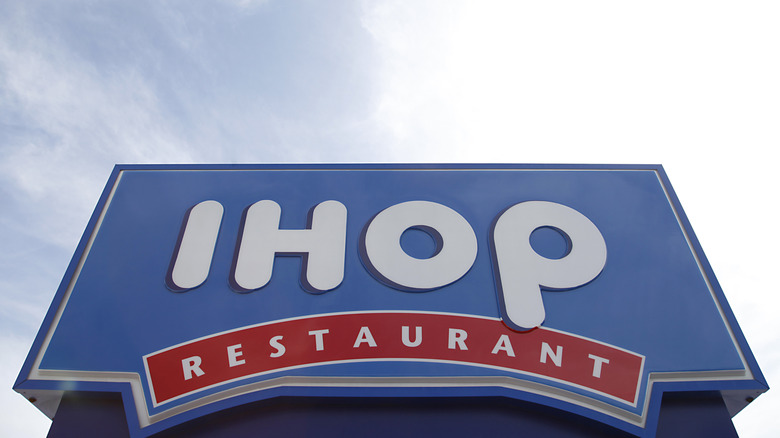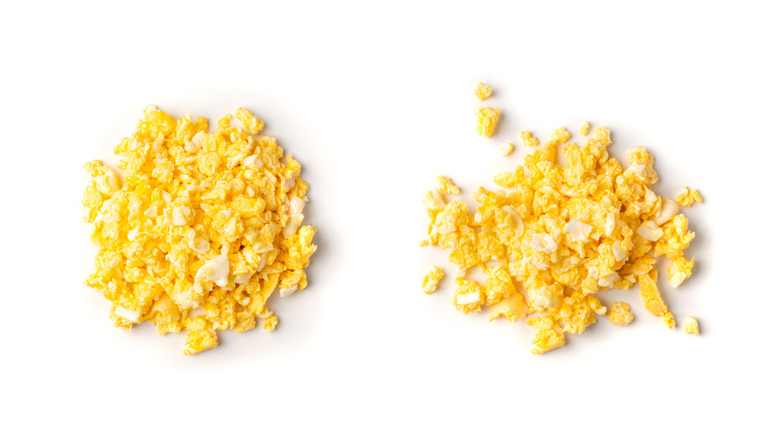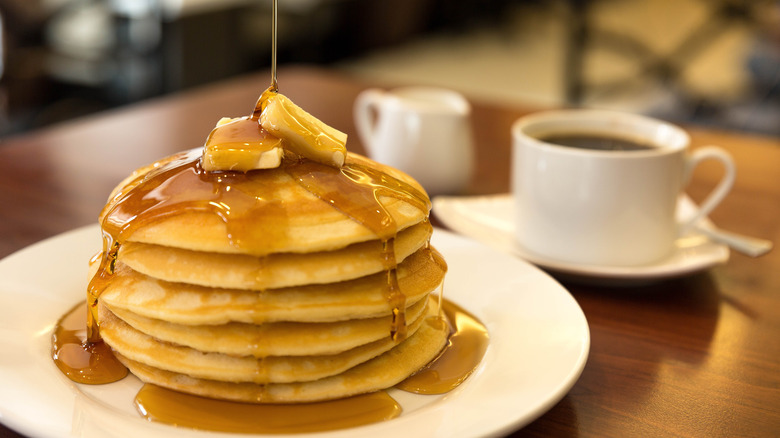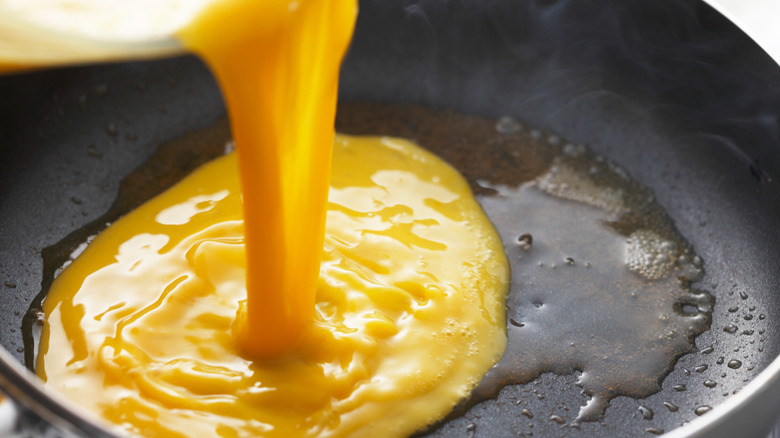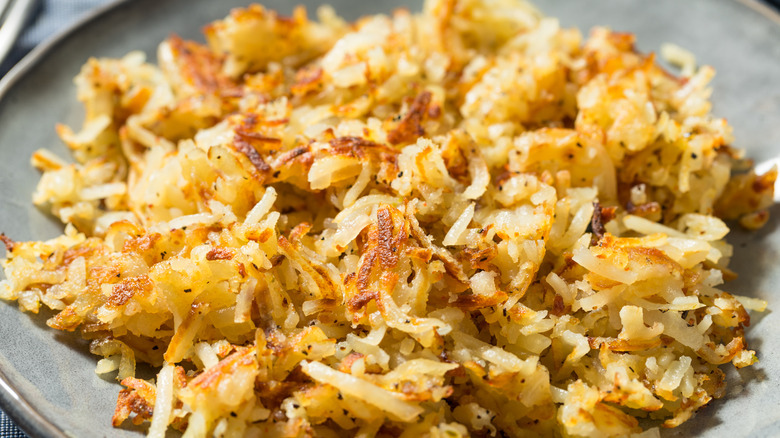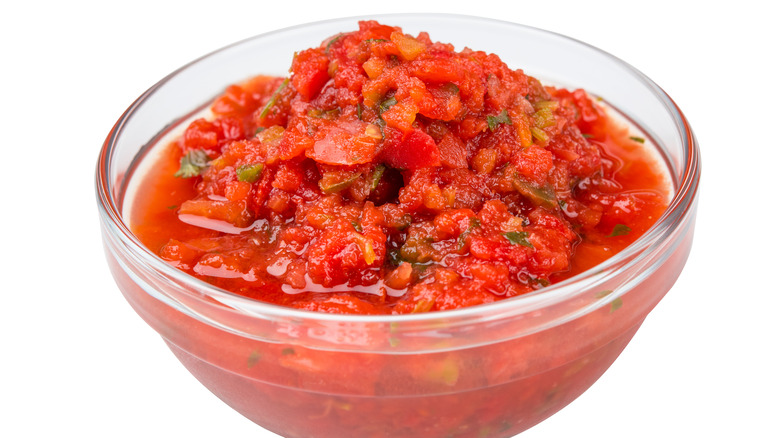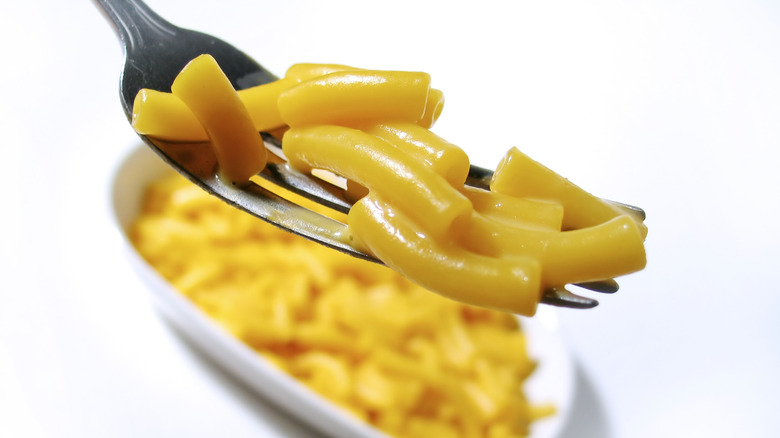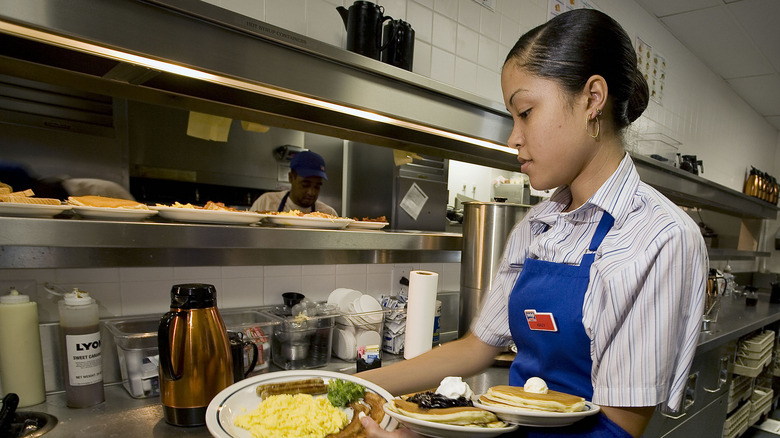We Finally Know Why IHOP Is So Cheap
Follow the smell of syrup and smoky bacon until you see a blue roof and there's a good chance you'll end up at an IHOP. IHOP opened its doors in 1958 and has expanded its classic brand of comfort food to over 1,600 locations across the US and abroad (via IHOP). Even though IHOP is best known for its breakfast, the casual chain also serves up lunch and dinner too. With a menu that offers everything from stacks of fluffy pancakes to juicy pepper jack patty melts, IHOP has a little something for everyone.
But how is it that IHOP can serve up huge portions of breakfast food for a relatively small amount of money? How does the restaurant turn a profit when its menu is so extensive and reasonably priced? We investigated to uncover the truth and you may be surprised by some of the answers. We finally know why IHOP is so cheap.
It uses bagged eggs
Eggs are nutritional powerhouses. One single egg contains six grams of protein and many vitamins and minerals (via Healthline). Yet the average price for a dozen eggs in the US is only around two bucks, which comes out to about sixteen cents an egg. At that rate, an omelet made with three fresh eggs should only cost about fifty cents. You'd think with prices that cheap, IHOP could afford to use fresh eggs in all of its breakfast dishes. Instead, the company supposedly makes its omelets and scrambled egg dishes with an egg substitute. Mmm ... egg substitute. Doesn't exactly rev up your appetite, does it?
An alleged former server shared this startling fact on social media. He claimed that his training manager told him that IHOP uses a liquid egg substitute for many dishes (via TikTok). However, a Redditor claiming to be an IHOP cook said the restaurant actually uses bagged liquid eggs. They're not freshly-cracked eggs, but we wouldn't exactly call them a "substitute," either. The former server on TikTok goes on to inform the world that IHOP's secret is that you can get freshly-cracked eggs if you want — you just have to specifically request them when you order.
It doesn't use real maple syrup
Maple syrup is the liquid gold of breakfast. And it's kinda priced that way too: real deal maple syrup usually costs $8 or more for a 12.5 oz. bottle, while the fake maple syrup only costs about half of that.How can you tell the difference? If it's authentic, there should be just one ingredient on the label: maple syrup.
The stuff you drizzle on IHOP's pancakes is not real maple syrup. Taking a peek at the nutrition facts for IHOP's "old fashioned maple syrup" shows that it contains corn syrup, sugar, caramel color, artificial flavors, preservatives, and thickening agents. Interestingly, the word "maple" doesn't appear even once on the ingredient list — which makes you wonder how IHOP can even get away with advertising it as old-fashioned maple syrup to begin with.
When the vast majority of your business model depends on pancakes, it's more profitable to find low-cost alternatives to real maple syrup since it's so expensive. Because the price difference is so dramatic between authentic maple syrup and the phony stuff, there's no doubt that using fake maple syrup is a way for IHOP to save money and keep costs down.
It bulks up omelets with a secret ingredient
The beauty of an omelet is its simplicity. With just a few beaten eggs and some butter, you can whip up a luscious dish that's filling and nutritious.
You wouldn't expect a popular breakfast restaurant like IHOP to rock the boat too much when it comes to omelets, but the company has a bizarre trick up its sleeve: Pancake batter. According to The Daily Meal, IHOP adds a little bit of pancake batter to its omelets. Apparently, the pancake batter gives the omelets more structure and also makes them fluffier. A look at the nutritional label for IHOP's omelets confirms this, showing that after eggs, the next two ingredients are flour and sugar — the main components of a pancake. Adding pancake batter to omelets may provide some textural difference, but it also makes them look a little bigger without adding any extra eggs. By whisking in some flour and sugar into its omelets, IHOP has found a cheap way to bulk them up.
IHOP uses dehydrated potatoes for hash browns
Potatoes and breakfast go hand-in-hand. They are a key player in crispy hashes, fluffy frittatas, and loaded breakfast burritos. But perhaps the most beloved breakfast potato dish is the hash brown. Shredded thin and fried golden, hash browns pair perfectly with just about any egg dish and breakfast meat on your plate. There is, however, one undeniable downside to the cherished hash brown: they're fairly labor-intensive and time-consuming to make from scratch.
As a result, IHOP uses pre-made hash browns. An alleged IHOP cook on Reddit says that the restaurant's hash browns come "dehydrated in a big cardboard carton" and get rehydrated with hot water before getting grilled in a rack. This claim seems to check out, judging by the preservatives listed on the nutritional info for hash browns on IHOP's menu online. By using pre-made dehydrated hash browns, IHOP is cutting down on a lot of prep time so that the restaurant's cooks can quickly prepare them to keep up with demand. Being able to efficiently pump out hash browns ensures lower prices because there's much less labor involved.
It uses pre-made salsa
Admittedly, IHOP isn't exactly well-known for its Mexican food, so it should come as no surprise that the restaurant cuts corners when it comes to its salsa. The alleged IHOP cook on Reddit came forward with another claim: that the restaurant uses salsa that comes from a distribution center. Looking at the nutritional info on IHOP's online menu shows that its salsa contains xanthan gum, caramel color, and a preservative called sodium benzoate. Obviously, these aren't ingredients that are typically added to a batch of fresh salsa, so the cook's claim seems to check out.
Salsa is another dish that can be somewhat tedious and time-consuming to prepare. It makes sense that IHOP would want to simplify its salsa, especially since it only appears in some of its bowls and burritos. By giving its cooks salsa that's pre-made, IHOP cuts down on the amount of time it would take them to prepare it totally from scratch.
IHOP sources cheap fish
When something is cheap, it usually comes with a catch, and that's also true for tilapia. With its mild flavor and affordability, tilapia has become one of the most popular types of seafood in the United States (via Healthline). According to the Washington Post, part of the reason tilapia is so cheap is that the fish grows fast and is amazingly resilient. Capable of tolerating a wide range of temperature and salinity changes, tilapia can also manage to thrive in crowded freshwater environments.
The downside? 73% of our tilapia comes from China — and China has been busted for feeding animal feces to the fish on its farms. There's also evidence that tilapia are exposed to illegal antibiotics and antimicrobials. Despite this, tilapia remains popular and IHOP offers a grilled tilapia dinner with two seasoned fish fillets for under $15. By putting one of the cheapest fish on the market on its menu, IHOP is offering an inexpensive dinner option.
IHOP's macaroni & cheese is made by Kraft
America loves macaroni & cheese. And for good reason: it's cheap, simple, and delicious. When many of us think back to some of the first foods we ever cooked on our own, there's probably a good chance that macaroni & cheese is somewhere on that list. According to Insider, about one million boxes of Kraft macaroni & cheese are sold every single day.
It makes perfect sense that a restaurant like IHOP that specializes in classic American food would add macaroni & cheese to its menu. But instead of taking the time to make it from scratch, it uses Kraft. Just to be absolutely clear: we aren't knocking Kraft. We definitely have a special place in our hearts for that blue box of macaroni & cheese from childhood. But there's no doubt that macaroni & cheese made from scratch is far superior, and let's face it — when we go out to eat at a restaurant, we're expecting it to be better than something we can easily make at home. That said, making macaroni & cheese from scratch takes time and there's no doubt that using all of that fresh cheese costs more. By using Kraft macaroni & cheese, IHOP is keeping the cost of this classic dish to a bare minimum, which makes it nice and cheap on the menu.
It pays low wages
IHOP makes a lot of money. In 2020 alone, IHOP topped more than two billion dollars in sales from its more than 1,600 locations around the United States (via Statista). There's no doubt that IHOP's cooks and servers are a big reason why the company has been so financially successful. Without their labor, the food wouldn't get prepared or brought to your table — and your cravings for IHOP's strawberry and banana pancakes would be nothing more than a daydream.
Yet, according to Payscale, the average hourly wage at IHOP is only $10.81 an hour. This hourly wage is far below the national median of $16.36 (via Statista). By paying its labor force low wages, IHOP is able to maximize its profit margin. In turn, IHOP's menu prices stay anchored on the cheaper side. That said, one study from Purdue University shows that increasing wages at restaurants to $22 an hour would lead to a 25% increase in prices — which means a stack of pancakes from IHOP would only cost you a couple more bucks.
